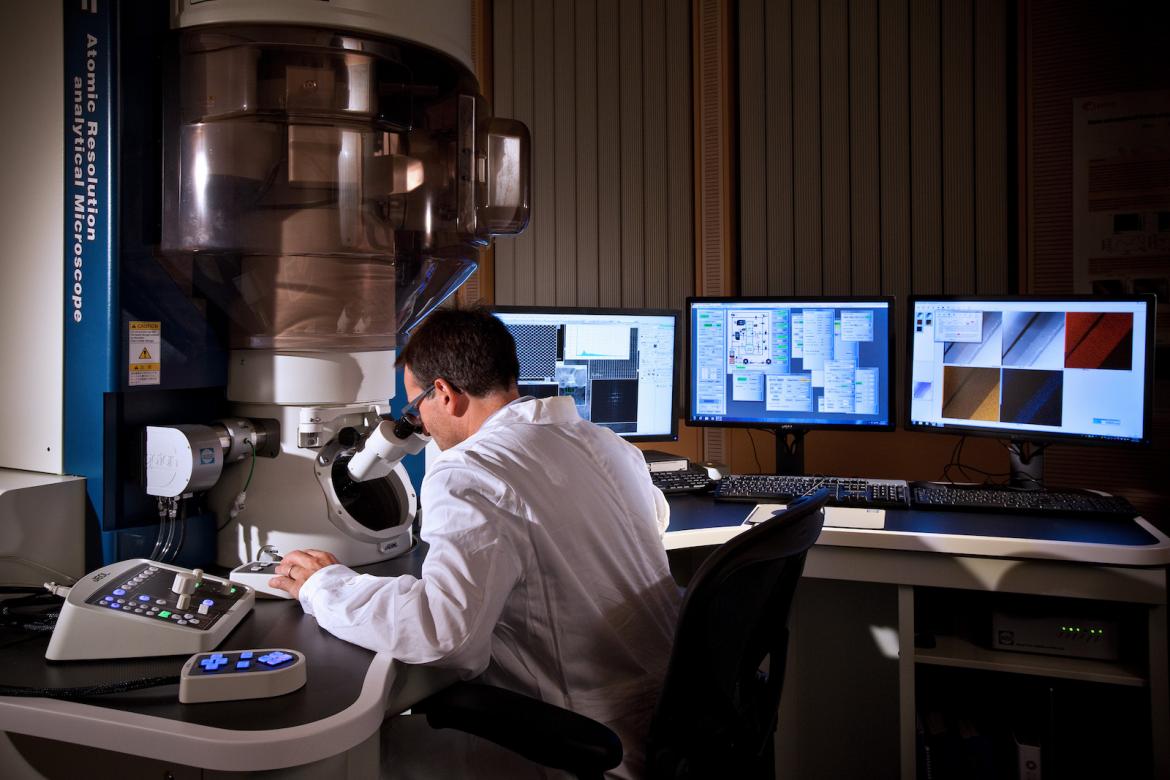
Head of the lab and contact person Giuseppe Nicotra
Founder Corrado Spinella
The Beyond-Nano microscopy lab in Catania is the largest center for Electron Microscopy in Italy. It is hosted at the headquarters of IMM-CNR laboratory one of the largest research center of the Italian National Research Council which cover a wide range of scientific activities aimed at manufacturing, understanding, modeling, and manipulating matter from the micrometer range down to the atomic level. The project Beyond-Nano is focused on the creation of a research infrastructure involving the best skills of southern Italy CNR structures in the field of advanced materials and nanotechnology. The fields of application will be focused on the investigation of multi-functional materials for applications in the followings strategic areas: energetic efficiency, photovoltaic, safety and health, nanoelectronics. The Beyond-Nano Catania, focuses on the characterization of nanomaterials, including their structural, electronic, and chemical properties at the nanometer scale, making use of the expertise in advanced TEM techniques. The staff expertise covers the fields of advanced TEM methods like: Electron energy-loss spectroscopy (EELS), energy-dispersive X-ray spectroscopy (EDX), in-situ TEM methods, image processing and simulation, soft matter and electron tomography.
Objectives and methods
The Beyondnano Catania aims to observe and study the materials with the aid of three powerful transmission electron microscopes. The ARM200F is only the last one and promises to get analysis with a resolution so high to go beyond the Angstrom even at low energy. This will allow the study of soft material such as graphene and polymers. Thanks to powerful analytical tools the beyond nano team will be able to obtain simultaneously chemical and structural information at atomic scale, and therefore understand how atoms are bonded to one another.
This will allow to carry out a wide range of super-fast devices and at low energy consumption, systems for storing huge amounts of information, tools for the identification of biological markers in very small quantities of fluids.
Graphene
Graphene is a planar one-atom-thick layer of sp2-bonded carbon atoms with remarkable electronic transport properties that make it a potential candidate for future electronic applications. In the last years significant advances have been achieved in the growth of laterally uniform graphene films over large areas, either by thermal decomposition of hexagonal SiC3 or by chemical vapor deposition on catalytic metals. However, graphene presents specific structural and electronic properties depending on the growth substrate and mechanism, which consequently have an impact on its macroscopic electrical behavior. To get a deeper understanding of this material a Cs corrected STEM operated at low energy is needed. The combination of the very high spatial resolution with the ability to work at an operating energy that is below the knock-on threshold for carbons is essential for his study. Indeed, under these experimental conditions, atoms in the structure can be clearly separated in the images, while electron energy loss spectroscopy (EELS) acquisitions are possible without damaging the EG structure.
How Submit a Proposal
Beyondnano facilities are addressed to national and international projects and scientific collaborations.
In order to ask access to the facility a proposal of the project must be submitted, and acceptance is subordinated as follows:
Collaborative project: Access to Beyondnano facilities is allowed through a collaborative project to researchers whose proposals are accepted by the Beyondnano proposal review committee.
Proposals are evaluated and ranked by an Proposal Review Committee based on the following criteria:
- Scientific merit.
- Technical feasibility.
- Need for Beyondnano’s unique or advanced facilities.
- Experience of the research group required to achieve the proposal’s goals.
- Availability of Beyondnano resources needed to support the proposed work.
Please describe clearly the specific goals and experiments planned for the new research.
Proprietary work: companies and research institutions seeking to utilize Beyondnano for proprietary work may submit a proposal if the requested instrumentation or expertise is not available in their area. Proposals for proprietary work will be reviewed by Beyondnano''s Proposal Review Committee and be evaluated based on the same criteria as non-proprietary proposals. If approved, there will be an instrument user fee.
Access to University: is subject to the conclusion of an agreement with the National Research Council (CNR)
Before you begin your research
Upon approval of your proposal, you will receive an email with instructions and contact information to start your work at Beyondnano. You must: Contact your assigned Beyondnano scientific advisor/contact to discuss the logistics of your project, included in the approval email you received. Discuss your arrival date. Complete all required badging and safety training no later than two weeks prior to your first visit to Beyondnano..
Instrument qualification
After completing the required safety training, a new user should contact the Beyondnano scientific advisor in charge of his or her proposal and arrange for the necessary instrument qualification sessions. Instrument instruction will include a demonstration of specific instrument characteristics and will depend on the experience of the user and the goals of the proposed work.
Accessing facilities and performing research
Beyondnano allows approved users to schedule instrument time. If a user has exceptional circumstances and needs to schedule an instrument session prior to the 15th of the preceding month, he/she should contact the assigned Beyondnano staff contact. Cancellations within 24 hours of scheduled instrument time will not be accepted and will be counted as a session unless authorized by Beyondnano staff.
All published work resulting from use of this facility must include an acknowledgement to Beyondnano as follows:
"This work was performed at Beyondnano CNR-IMM, which is supported by the Italian Ministry of Education and Research (MIUR) under project Beyond-Nano (PON a3_00363)".
Complete the Beyondnano Proposal Form by clicking on this link: BEYONDNANO online proposal form pdf , doc.
Follow the instructions carefully and be sure to provide the information requested. If you have questions about a technical aspect of your proposed research please contact us.

